Fantômas, Judex, Les Vampires, Tih Ming (1913, 1914, 1916, 1917, 1918)
Directed by: Louis Feuillade
Written by: Louis Feuillade, Marcel Allain
Starring: Edmond Bréon, Édouard Mathé, Marcel Levesque, Mary Harard, Musidora, René Navarre
LOUIS FEUILLADE: THE COMPLETE CRIME SERIALS
AVAILABLE ON BLU-RAY: NOW, from EUREKA ENTERTAINMENT

FANTOMAS [1913 – 1914]
RUNNING TIME: 337 mins
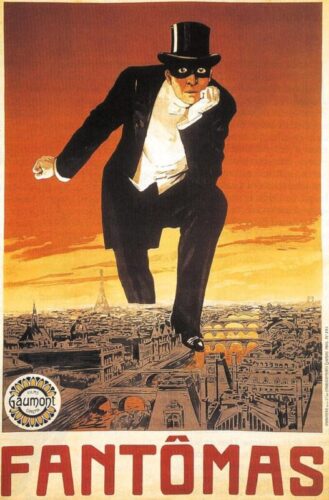
There’s a crime wave going on in Paris, and the person responsible is a certain Fantomas, who has a habit of wearing disguises nad has an army of helpers. On his case are Inspector Juve and his journalist friend Fandor, but Fantomas has another annoying habit; soon after he’s arrested he tends to escape again or be rescued. His newest accomplice ahd rescuer is Lady Belthane, the wife of Lord Belthan whom Fantomas has kidnapped; he’s forcing her to aid him but she doesn’t seem to mind engaging in villainy or becoming Fsntomas’s mistress….
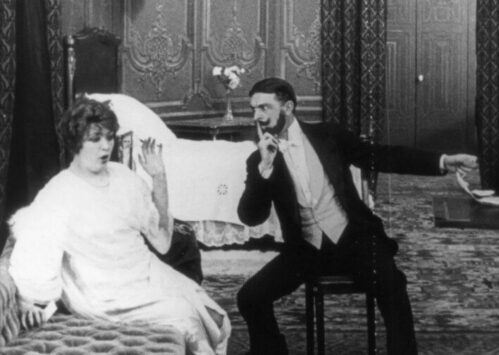
The name Louis Feuillade is certainly one I’d come across before. I became crazy about Alfred Hitchcock at quite a young age as I was seriously getting into film and he named Feuillade as an influence; you can certainly see this in many of his British films. Then later on came Irma Vep, the 1996 Hong Kong production where Maggie Cheung played an actress filming a remake of Feuillade’s Les Vampires, which was itself remade as a mini series with Alicia Vikander in 2002, though I saw neither. And then of course there’s the link between another one of my cinematic gods Mario Bava and Fantomas, who inspired the character of Diabolik which he put onscreen in 1967. So, when Eureka’s massive set of Feuillade’s four best known serials arrived through my letterbox, I was intrigued despite the amount of viewing time it would take up. Fantomas is the first and it’s a straight forward, fairly pacy slice of pulp fiction which I enjoyed considerably, despite the concessions one has to get used to, such as a camera which hardly moves, exaggerated acting to compensate for the lack of sound and a villain who wears obvious disguises which even Inspector Clouseau might balk at; check out possibly the most unconvincing fake beard in cinema history. Set in the real world but with some borderline-fantastical plot turns, the battle between the devious Professor Moriarty-like criminal mastermind and the Batman and Robin-like experienced cop and young journalist duo never lost my attention due to the piling on of the incidents and the twists, though I did only watch one or two episodes an evening; after all, these would have been originally seen a few months apart. It’s easy to imagine the almost non-stop robberies, escapes, murders, kidnappings and even a few action sequences, not to mention an anarchic villain who seems to commit his crimes just for the fun of it, thrilling cinema-goers of the time.
We first see the various incarnations of Fantomas himself, via dissolves, which you could say gives some of the game away though I reckon even back in 1913 it would have pretty obvious when he was onscreen despite his disguises. In any case, wasn’t this repeated by Fritz Lang in Dr Mabuse, The Gambler? An intertitle sets the scene “Part One – the robbery at the Royal Paris Hotel – it was 1 0 clock in the morning, when Princess Danidoff returned to her hotel”. She takes her time to get to her room – and this is something that some viewers might become impatient with. People often take a while to do things, and things take a while to happen. However, one only needs to remember that it wouldn’t have even entered into the minds of the filmmakers to speed these scenes up with tighter editing. A face peers out of the curtain when Danidoff and her maid leave the main part of the room, followed by a man who goes over to open a drawer, hides again when Danidoff returns, comes back out, hands her a blank card, grabs a jewel ehilee she’s looking at it, threatens her, kisses her hand, then leaves and strangles a guard to exit the hotel in his uniform, while the name “FANTOMAS” materialises on the card. So that’s our Fantomss; thorough, clever, and with a big ego, and given a great introduction. Now we meet Inspector Juve, reading dispatches with his journalist friend Fandor, and we learn of another crime, the disappearance of Lord Belthan, whose wife “was listening to a certain Gurn, whose disquieting charm had enthralled her”. Of course Gurn is You Know Who, and the Lord turns up dead in one of several cases delivered to “Gurn”s” address which also contains some of those special business cards!!
Fantomas is found and arrested, but Lady Belthane gets him out with the hope of two prison guards, a complicated undertaking which also involves an actor called Valgrad who’s reenacting Fantomas’s last hours in prison on stage in a nice touch, being so close to Fantomas in appearance that he could easily pass for him. It seems that Lady Belthane was his mistress and partner in crime, but she doesn’t like things like being forced to listen to the sound of the building of the guillotine that will be the death of Valgrad. Thus ends “In The Shadow Of The Guillotine”, but “Guve Vs Fantomas” is next, beginning with a disfigured body of a woman being foind in a certain Dr. Chaleck’s house. Fantomas has escaped from prison, but couldn’t we have seen this? A missed opportuuity for an exciting opening scene, but never mind, we soon have Juve and Fandor following Chaleck and a prostitute respectively, before Fa oh sorry Chaleck’s robbery of the prostitute’s rich admirer and then – and this was a real surprise – causing a train crash to kill a whole load of witnesses! The model shot of the crash may not look convincing but nor do similar shots done 40 years later, and it’s the sheer callousness of Fantomas’s actions that dominates thoughts. Thus guy is ruthless! Juve and Fandor then nearly kill each other during a shootout on a beach, while Mrs. Belthane starts to regret being an accomplice to crimes but is under Fantomas’s spell. Fantomas keeps on doing bad things, which our cop and journalist investigate, usually eventually tracking Fantomas down, but Fantomas is always able to escape, even from captivity.
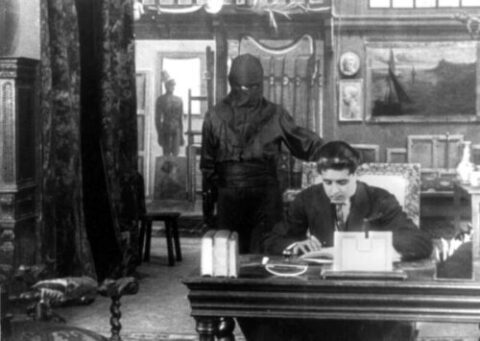
Repetition does develop, but plenty of fun stuff is always occurring, from Juve being accused of being Fantomas, to one of those levers that seem to exist purely so that a place can be blown up [i.e. Bride Of Frankenstein], to so much wearing of disguises, with our three main characters constantly fooling each other and even impersonating impersonators, that one wonders if a point is being made about identity. We never really know who Fantomas is a rob. Of course there are other crooks, one of them able to get away with his thievery because he’s been wearing the skin of somebody else’s hands. Ugh!! Of course each main chapter ends with a cliffhanger; I say “main” chapter because each chapter itself contains three of foutrsmaller chapters with titles like “The Murderous Corpse”. The storytelling is sometimes rather obtuse because people are often talking at a distance with very few intertitles appearing. The camera just sits there, letting shots and scenes go on for ages, often seemingly in real time [such as when Fandor cuts his way out of a wicker basket], while the performers at times act with their backs to the audience and there’s little attempt at precise compositions. But this is how films were back then, and there are pluses to this primitive filmmaking. It feels more realistic, as if we’re an observer of events, and the plentiful outdoor footage of Paris at the time is interesting, especially with those fashions. There’s not much of an attempt to create an atmosphere, though there are a few shots that play with dark and light well, perhaps most notably one where we see a woman inside her house, everything being dark except for the daylight streaming in through cracks in a door; the front door is then opened which brings in more light.
Our title character seems to enjoy stealing most of all, and one has to like his anarchistic streak, even if we don’t get to know him as a character and he’s ruthless at bumping off opponents, witnesses and traitors. Our title character seems to enjoy stealing jewelry and money most of all, and one has to like his anarchistic streak, despite his efficiency at bumping off opponents, witnesses and traitors. Perhaps the most memorable kill is when he hangs a man inside a church bell so that he dies when the bell is rung. Rene Navarre makes the most of playing a host of different characters who are all up to no good, while Edmond Breon is also great fun to watch as he unhappily plods around putting clues together for much of the time but can go into action if he needs to. It’s a shame that he’s not much in the final episode, as the dynamic between Juve and the youthful, more energetic but less experienced Fandor is nice, if not used to as much advantage as would have been a couple of decades later. There are only three major female characters, two of them only being in one episode, but the recurring Lady Belthane [Rene Carl] is rather intriguing, a villainess who cheated on her husband with Fantomas [though of course as one of his aliases], carries on the affair even when Fantomas murdered him, being very much under his control, but begins to see the light. The scenes between the two have an edge, but she disappears from the narrative in a rather unsatisfying fashion. Indeed Fantomas as a whole winds up a bit disappointingly, the fifth episode, which has some footage missing from it near the beginning though text has been inserted to explain what happened, not giving us much of an exciting climax, while the final twist in the tale is quite predictable. Nonetheless Fantomas, despite its primitive aspects, manages to be still quite engrossing when seen today.
Rating: 









DISC ONE
FANTOMAS [1915]
1 – IN THE SHADOW OF THE GUILLOTINE [56 mins]
Audio commentary by film historian and author David Kalat
“An absolutely essential text”, says Kalat, “a key work in the history of suspense thrillers and one of the most influential early films ever made”, before continuing with “I hope that in the course of the next couple of hours I can persuade you of that position”. Well he certainly he has a good go at this in both of his tracks, which are from the 2010 Kino Video release. He perhaps apologises too profusely for mangling his French, but then soon provides plenty of interesting information on very early cinema, before going on to Fantomas himself. We hear a lot about the many books he was in, which ran for decades; one had Fandor romance Fantomas’s son who was really his daughter!” This serial saw the character become a pop culture icon; Navarro was almost lynched by a mob who couldn’t make the distinction between him and the person that he played, and that the French government tried to ban this because of Fantomas’s immorality. Kalat clearly loves talking about all this and nicely finishes this track with some “cliffhangers” of his own.
2 – JUVE VS FANTOMAS [52 mins]
Audio commentary by David Kalat
Kalat answers his cliffhangers he whetted our appetites with in his first track, as well as covering all sorts of interesting stuff related to the serial, including the inspirations for the Fantomas character, the chief of which was a guy named Vedark, a criminal who turned good and used his skills to catch crooks, the many remakes, sequels and knockoffs, and why episode 6 of Les Vampires has a flashback to Spain; Feuillade had shot that footage earlier for a film what had been aborted. All throughout, Kalat’s love of the subject matter is evident.
3 – THE DEAD MAN WHO KILLED [90 mins]
DISC TWO
FANTOMAS continued
4 – THE HUMAN SKIN GLOVES [90 mins]
5 – FANTOMAS VS FANTOMAS [71 mins]
Casting a Long Shadow: interview with Kim Newman [24 mins]
Newman, with his collection of Feuillade discs and books on display, explains how revolutionary Fantomas was, a film which not only combined the two maim kinds of movies at the time – real footage playing out and the George Melies-style dreamlike fantasy – but essentially predates the most popular type of picture these days, the fantasy actioner. He also discusses influences in a time where the super villain predated the superhero, before going on to briefly discuss the next three serials in a way which makes thos featurette one to watch after one has watched all four.
LES VAMPIRES [1915-1916]
RUNNING TIME: 417 mins
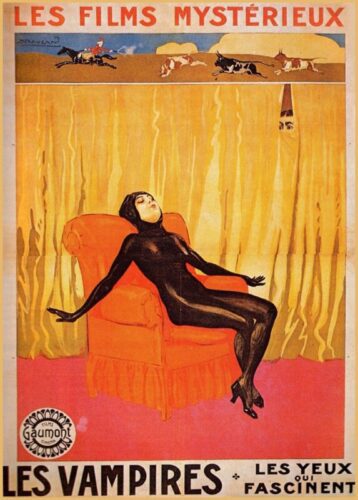
There’s another crime wave going on in Paris, and the group responsible are known as the Vampires, led by the Grand Vampire who has a habit of wearing disguises. On their case are reporter Philippe Guérande and office boy Oscar-Cloud Mazzametti the Office Boy. A disguised Grand Vampire poisons Phillppe’s fiance Marfa, then Phillipe comes in possession of a booklet that contains the crimes of the Vampires, but he has decode it, and the Grand Vampire unleashes his deadliest weapon, a devious minx named Irma Vep…
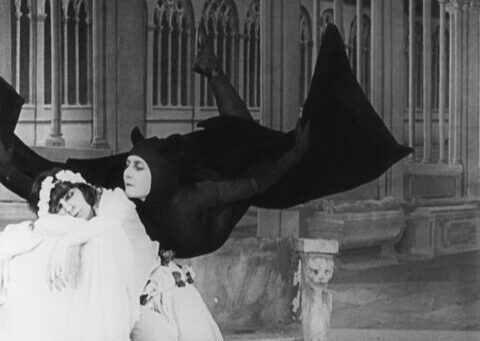
You always have to chuckle when Lon Chaney’s Count Dracula thinks that Count “Alucard” [“Dracula” backwards] is a good alias. And I imagine that some folk back in 1915 or 1916 also chuckled at the name of Irma Vep, which of course is an anagram of “vampire”, before – actually no, they probably weren’t disappointed that neither she nor any of the other “vampires” in this serial were actually vampires, because vampire movies weren’t a thing back then. However, they certainly are now, so even I, not knowing that much about it [haven’t even seen the Maggie Cheung Irma Vep], was disappointed, despite Les Vampires being a distinctive advance on Fantomas in most respects. The episodes were partly made up as they went along, so the storytelling is more random, but that’s not always a bad thing, it can sometimes create a nice feeling of spontaneity, and it certainly does here. And, while much of Les Vampires just rehashes the formula, indeed the ingredients, of Fantomas, it generally does it better, with Feuillade showing a much greater grasp of things like composition and editing while still maintaining the aesthetic of us just watching things unfold. It initially seems that this one is more about the good guys than the bad guys, with our journalist [who carries and uses a gun, but then I guess French gun laws weren’t the same back then] the main character, but the focus becomes more and more on Miss Vep, apparently the silver screen’s first “vamp” character, and no doubt such a sensation that public appetite was the reason for her increased role – and she’s just great, indeed so great that we don’t mind and even enjoy the over the top , even for silent movies, way that actress Musidora emotes; it doesn’t at all affect the fun of the proceedings.
This one has a slower introduction. “WHO HAS ROBBED JOURNALIST GUERANDE, AND WHY”, screams a newspaper headline. We’re introduced to reporter Philippe Guérande and Oscar-Cloud Mazzametti the Office Boy; the latter is in trouble because his three kids are threatened with being taken into care if he doesn’t pay for services, but Philippe gives him some money. He’s then assigned to a “sensational but dangerous” case; the Vampire Affair. He receives a telegram at work stating that the decapitated body of the national security agent in charge of the Vampire investigations, Inspector Durtal, has been found in a swamp, with the head missing. He spends the night in a nearby castle owned by Dr. Nox [“I know nothing about the vampires, only that everyone fears them”] an old friend of his father, along with Mrs. Simpson, an American multi-millionairess who wants to buy the property. It feels like we’re in one of those “old dark house” mysteries for a while, especially with the shots of Mrs. Simpson in her bedroom, particularly a tremendous bit where a hooded figures enters, accompanied by use black lighting and just a bit of white, to steal her money and jewels, showing that there was thought devoted to the visual aspect this time around. Meanwhile Philippe finds a note in his pocket saying “Young man, you would be well advised not to get involved with the vampires, it will bring you bad luck”, and discovers a mysterious passage behind a painting. Philippe is suspected of the theft, then the missing head is found – and yes, we see it – Mrs. Simpson is dead and Dr. Nox vanishes. Mrs. Simpson’s pocket contains a note from the Grand Vampire saying that he’s murdered the real Dr. Nox and is now assuming his identity, while this first chapter concludes well with a shot of a vampire crawling on a rooftop and climbing down a pipe.
The Grand Vampire, now disguised as Count de Noirmoutier, reads that ballerina Marfa Koutiloff, who’s engaged to Philippe, will perform a ballet called “The Vampires”. To prevent her from publicising the Vampires’ activities and to deter Philippe, he gives Marfa a poisoned ring which kills her onstage [though he suddenly has another fiance in episode 7], a shame as the performance is fascinating, a black winged vampire woman threatening a white-clad one. Philippe recognises the Grand Vampire and follows him to an abandoned fort where he’s captured. They agree to execute him at dawn, but the Vampire guarding him is actually Mazamette. They capture the Grand Inquisitor, then the police raid the lair. The Vampires escape, but as they flee they mistakenly execute the Grand Inquisitor, who turns out to be – the Chief Justice of the Supreme Court! While faking illness to get off work, Philippe tries to decode a booklet that he lifted from the Grand Inquisitor’s body, which very conveniently contains the crimes of the Vampires. Following clues, he arrives a night club where Irma is performing. The Grand Vampire assigns Irma to retrieve the booklet, and she disguises herself as a new maid, but Philippe recognises her. She tries to poison him and fails, but along comes the Grand Vampire, though it’s one of several convoluted plot elements that she should need him; surely she could kill Philippe in his sleep herself? His mother is then kidnapped though, and there’s also Juan-José Moréno, a businessman but actually another crook, who asks for an apartment with a safe. Some of what follows pits him against the Vampires, while Irma gets involved with him after he’s kidnapped her.

As in Fantomas, we get a lot of arrests, escapes and disguises, but the plotting is often even flimsier, and some episodes seem to contradict earlier ones. But this does mean that you often don’t know what’s going to happen next, though we di know we’re probably going to get a new gadget; the origins of Q Branch can be seen here, what with poison rings, poison fountain pens, cabinets with fake back panels, etc. The pacing is faster, with takes that aren’t always as long and even cuts to closeups when something is considered to be of importance. A good early example of providing visual information is Irma being reflected in Philiipe’s mirror. And does this have the cinema’s first flashback? Or was that Birth Of A Nation? One action scene involves a minor character being attacked by three bulls; he shoots dead the first two before getting the third to stay still, which he then unneccessarily kills with his sword, us cutting to real bloodily dying bulls each time in what will be an unpleasant sequence for some. When a car chase has Philippe follow a trail of oil left behind Irma’s speeding car, he stops several times to point out the clear path splattered down the middle of the road in a very quaint moment. There’s a great robbery on a speeding carriage, but the most exciting bit is probably when Phillipe is hypnotised inside a house which will soon collapse because of a bomb; some faster editing to heighten the suspense is attempted. It’s great to find out that, even back then, screen villains weren’t too keen on just shooting the good guys, preferring more fun methods. Nice to see the good guys play dirty too: when the villains flee from their hideout, a booby-trapped fire escape drops them several stories. It’s interesting to see incompetence rife with both the goodies and the baddies; it seems to be a theme. At one point Philippe is grabbed by the Vampires and whisked into a large costume box. He’s driven away and the box is unloaded, but poorly, and it slides down a large flight of stairs where he’s let out by two bystanders!
Philippe is often ineffectual, and it doesn’t help that Edouard Mathé is rather uncharismatic in the role, but that could be one of several reasons as to why Mazamette, played by Marcel Lévesque, is increasingly foregrounded. Sometimes he’s funny, such as when he does a double-take at a chalkboard caricature of his long nose drawn by the Grand Vampire. but more often then not he’s irritating in his goofiness, especially when he keeps playing to the camera, his nadir possibly being when he leers to us about a maid, even though he’s married, or was that forgotten, especially when he seems to be interested in Augustine, the widow of one of The Vampires’ victims? And then his young son, having been just expelled from school for “unruly behaviour“, is roped into doing some legwork, which might be too much though he’s not onscreen for very long. However, the character’s antics were probably popular at the time, and the inclusion of the child is one of the most noticeable ways in which the serial changes somewhat, from lots of mass murder to less carnage and a slightly gentler approach. Was this due to an early realisation of the lucrative lure of the kiddie market, or the threats of censorship from the disapproving French government who didn’t like the way that the villains were killing all these people and getting away with it? Of course Musidora’s Irma is the true star – we even learn a bit about her background – and Musidora is incredibly hypnotic and sexy despite the theatricality of her performance. Shot really cheaply – we get some very obvious re-using of furniture inside the artificial interiors as well as what looks like some stock footage – but not making the mistake of Fantomas‘s rather undramatic finale, Les Vampires can still involve and thrill.
Rating: 









DISC THREE
LES VAMPIRES
1 – THE SEVERED HEAD [33 mins]
2 – THE KILLER RING [15 mins]
3 – THE RED CIPHER [39 mins]
Brand new audio commentary by David Kalat
Kalat continues his providing of information on the films in question and background material in two new commentaries. We learn about the film environment in which these were made, the studio Gaumont specialising in adapting pulpy well known properties, while The Perils Of Pauline was the hugely successful American imitation. He also tells us that they had to use a lot of artificial sets in these serials because of the amount of lighting needed, and looks at Feuillade’s filming style which has more to it than at first seems apparent. This and all successive commentary tracks are new to this release.
4 – THE SPECTRE [48 mins]
Brand new audio commentary by David Kalat
Kalat apologises a THIRD time for his bad French pronounciation, which is surely overdoing it a bit, before carrying it on. He tells us that the film that some of the characters go to see is a Feuillade movie, that sources differ and we don’t know if his serials were being included chapter by chspter or as whole films, but that Feuillade may have made 800 films, and clears up the issue of the flashback I mentioned; seems that both Feuillard and Griffith were beaten way back in 1901 by History Of A Crime.
DISC FOUR
LES VAMPIRES continued
4 – DEAD MAN’S EYES [35 mins]
5 – HYPNOTIC EYES [54 mins]
6 – SATANAS [46 mins]
PAMELA HUTCHINSON ON MUSIDORA [23 mins]
We learn some things about this interesting actress who has such a vivid screen presence, from [so she claimed] that she met lots of prostitutes while doing research for a role that she was playing on stage and, on the third night, they were customers and applauded her performance, that many of her characters were inspired by her mentor Collette, and that she directed and produced a fair few films, though The Magic Image, a tribute to Feuillade, is sadly lost.
DISC FIVE
LES VAMPIRES continued
8 – THE THUNDER MASTER [49 mins]
9 – THE POISONER [48 mins]
10- THE TERRIBLE WEDDING [60 mins]
11- THE SPECTRE OF WAR IN “LES VAMPIRES”: Essay by Elizabeth Ezra [11 mins]
France was one of the countries most hit by WW1, so it makes sense that something like Les Vampires should be influenced by this despite its escapist nature. Ezra informs us that has allusions to code breaking and metaphorical usage of the subject of war trauma, while the Grand Vampire was killed off dearly because actor Louis Luna had to return to the front.
JUDEX [1916]
RUNNING TIME: 300 mins
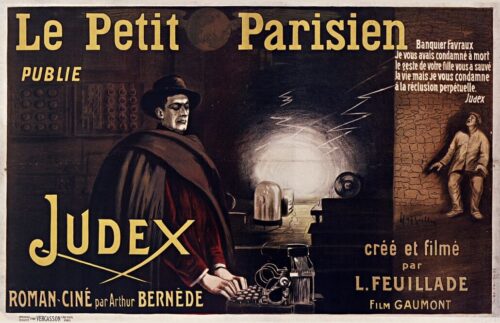
Favraux, a corrupt banker living a life of luxury in Paris, receives a note from an avenger named Judex, claiming that he must turn over half of his fortune or else. Favraux hires a private detective, Cocatin, to protect him, but at his daughter Jacqueline’s engagement party that night, he suffers what appears to be a cardiac attack, and dies, though he’s not dead, and is taken by Judex and his brother Roger to be imprisoned in Judex’s laboratory. Jacqueline gives the entire fortune away. A pair of crooks, Diana Monti and Morales, were originally after Favraux’s money before he “died” and are now after Jacqueline and her son, Jean….
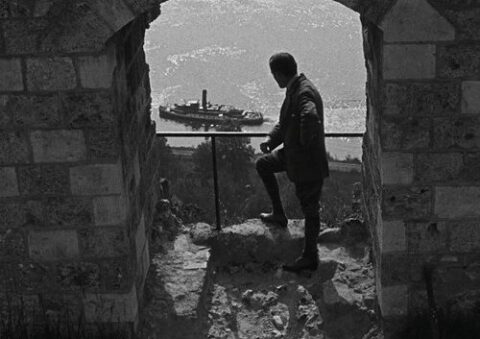
And so we have probably the silver screen’s first superhero. Judex was obviously made by Feuillade and Gaumont as an answer to the fuss made, to the point of threats of bans, by the French government and police over the supposed glamourisation of mass crime in Les Fantomas and Les Vampires. And, while it still follows many conventions and even brings back Isadora and Lévesque who’d both been popular in Les Vampires, there’s a somewhat different feel and approach here. The plot is much smaller in scale, there’s far less actual crime on offer, there’s not as much time spent on thrills and more time taken up with melodrama and sentimentality and, despite ingredients such as suicide and sexual intrigue, it’s obviously designed to appeal more to kids, with not one but two prominent child characters, one of whom is an Artful Dodger-inspired boy whom very young viewers of the time would have really looked up to and loved. The main title character is a do-gooder, though he’s surprisingly limited in terms of his screen appearance; in fact the villains, especially Isadora’s Diana, appear on screen much more. Nonetheless, the imposing cloaked and hatted man in black, even though he’s surprisingly ineffectual, was designed to have the maximum impact, and was clearly the main inspiration for The Shadow, who of course was the main inspiration for Who Know Who; he even has a Batcave full of gizmos. And Feuillade’s grip of film technique has leaped forward again, with plenty of shots that are well thought through to the point of attempting some depth of staging and vision, some fine use of black contrasting with white, and editing used far more to heighten moments. It’s fascinating to watch these serials and see the art of movie making advance each time.
This time the chapters are much shorter, though this “prologue”, which is basically “chapter one” is by far the longest episode. We first see “Morales, an ex-convict and his accomplice, known as Diana Monti”; she gives him a letter which confirms her new “job” as a governess called Maria Verdier, though of course we already know that there must be more behind this. She’s to work in the house of banker Favroux, who’s daughter Jacqueline has been a widow for four years, and has a son called Little Jean, who’s actually played by a girl, with little attempt to disguise this. Is this something that audiences back then would have accepted? My knowledge of movies that were made over a hundred years ago might be slightly more than the “average Joe” but is still very rudimentary compared to the “experts”. Jacqueline receives [the sending and getting of letters happens all the time in this one, which makes this hardly young critic rather nostalgic for that time before the age of the text message] a marriage proposal from “a ruined debt-ridden noble” called Amaury de la Rochefontaine”, and accepts. Meanwhile an old mill owner named Pierre Kerjean who lost loads of money due to Favroux’s banking practises and was then “sentenced for thirteen years of hard labour” for having to turn to crime, is out of prison and looking for his son. He thinks that Favroux may know something, but, seeing as it’s his daughter’s wedding, he doesn’t want to speak to him. Pierre understandably loses it a bit, then Favroux, spotting him in his car, has his driver run him over. He then receives a letter from “Judex” telling him to give up half his fortune and give it to local hospitals to atone for his sins, so he visits Celeritas Agency in Paris where the manager has just died so his nephew Concantin is in charge – and I can certainly imagine 1016 audiences cheering when Lévesque came onscreen. I didn’t.
A second letter from Judex saying that “there will be trouble” if he hasn’t given his monet to welfare by 10pm results in Favroux collapsing dead at a big family dinner. Concantin and us soon learn of the depth of Favroux’s nastiness, with not just mass sackings but the causing of suicides and not-so-mysterious arson claiming the deaths of thirteen workers. Jacqueline, who’s certainly not like her father anyway and didn’t even seem to know of bis crimes but who takes the threat seriously, bequeaths his fortune as ordered, which pisses off hubby, who only really wanted Favroux’s money. Jacqueline entrusts her son[!] Jean to a lady named Marianne before going out into the night in a rather powerful moment with great use of her shadow which follows her – are we seeing the routes of that wonderful thing named German Expressionism here? Where’s Judex, you might ask? Well, we finally see him in the flesh now, taking Favrous’s body, with help from his brother Roger, from the morgue because Favroux only had catalepsy, but we shift to Jean, who’s being brought up by her foster parents on a farm, while mother lives in a boarding house teaching piano. We see Oscar, the brother of one of her students Gisele, claiming love for her and trying to kiss her, and soon after that he with Morales and Diana in a “shady” bar talking dastardly plans. Meanwhile Judex and Roger have imprisoned the now amnesiac Favroux and want him to repent, but Judex falls in love with his daughter. We keep shifting to other subplots, especially Jean sneaking away to find his mother and befriending The Licorice Kid, a street urchin who helps her considerably. People often come back from the grave. And why is Favroux’s old secretary Vailliere being so helpful, as well as telling her that Judex is in love with her?
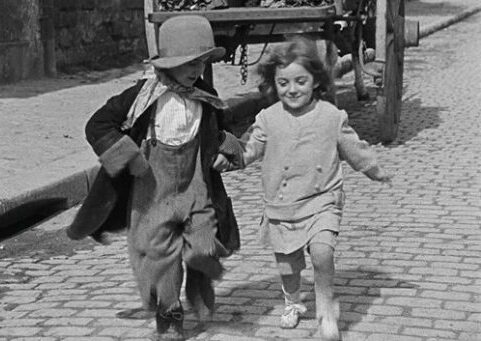
Unlike the first two of these serials which slowed down a bit after some time, this one ramps things up in the second half, though there’s still a large amount of time spent on the emotions and the relationships of the characters, most of whom are related to each other in some way. The most memorable action beat is in chapter three where Judex and his brother Oliver have to rescue Jacqueline, in the first of several times, and accompanying them is a pack of dogs. The animals knock a bad guy over and lead them to Jacqueline, then Judex gives her a letter saying that the dogs will lead to safety, which they then do. The sequence doesn’t entirely make sense but even seen from today it’s rather original. Judex had two cinematographers – Andre Glatti and Leon Klausse – and perhaps understandably so because this one tries to be genuinely visually pleasing and interesting in a way that even Les Vampires never came close to being, right from having scenes where characters are at much greater variety of distance from the camera in an attempt at depth. The old really lengthy still shots are trimmed even further except for when Feuillard alights on something he wants to emphasise; towards the end the camera lingers on a ship sailing from right to left for a whole minute, a ship that later on we get a gorgeous sunset shot of. Many of the scenes featuring Kerjean, often seen in nature, are slow and contemplative. And many scenes feature proper cutting to visually connect people and emphasise emotion. The best example of this is when Judex is in his cave thinking of someone, the next cut to Jacqueline in bed revealing it to be her, but then we cut to Jean, also in bed, showing that he’s what she’s thinking about.
No doubt because Feuillard was playing it safe, Judex, played with authority but very subtle vulnerability by Rene Creste in a very well controlled performance, is limited for much of the time to sending letters. Sometimes Roger has to give him pep talks. He doesn’t actually want to kill anybody, and is being pushed in his quest for revenge by somebody else. which we have revealed to us in another and lengthier flashback. On the other side of the coin, Favroux is shown as a truly despicable person, yet he soon loses his memory and is powerless, one of several interesting plot turns. In fact two of our three villains are allowed to be a bit sympathetic by revelations or circumstance; we’re even told that Morales was led into a life of crime by an evil woman – and we know who that evil woman is. Misadora is just as hypnotic as before and is given the chance to play a perhaps even more complex character. As Cocantin, Marcel Levesque is much like before, goofily annoying even when his character doesn’t need to be, though he does virtually turn the idea of breaking the fourth wall into an art form. Cocantin has a lot of scenes withan ex-girlfriend [Yvonne Dario] who suddenly conveniently appears towards the end to be an important ingredient in the storytelling, though overall Judex is more tightly plotted than the previous two serials. And it’s as interested in when characters reveal things to each other as it is the usual stuff, the finale being all about repentance and forgiveness. Some may find it sickly and going on for too long, but I found the emotional honesty and kind nature on display to be rather touching, even if I questioned the letting off of one character to be rather excessive.
Rating: 









DISC SIX
JUDEX
PROLOGUE [40 mins]
Brand new audio commentary by genre film expert and Video Watchdog founder Tim Lucas
Lucas takes over the reins for the last four commentaries; his relaxing voice is always nice to hear even when he’s clearly trying to cram in as much as he can. He begins by mentioning how Isadora is credited under all the male actors despite having so much screen time, while Louis Leubas, who plays Morales, is given top credit! He also details Judex’s creation – Fueillade stated that he wanted it to “be popular in the greatest and most wholesome sense of the word” and “made every effort to please child and adult”. Portions of the novel were released in publications just before each chapter of the film, and Lucas notices a recurring door.
1 – THE MYSTERIOUS SHADOW [31 mins]
Brand new audio commentary by genre film expert and Video Watchdog founder Tim Lucas
After reminding us that the credits are more recently done Lucas wonders if they make a mistake in exposing who played Judex, draw our attention to how there’s often stuff in the background or going on in the background, such as Diana reacting to two men talking, in a thorough examination of the filming style, and thinks that the coda in the “Batcave” cave is pointless.
2 – ATONEMENT [21 mins]
Brand new audio commentary by Tim Lucas
Lucas points out possibly religious elements though he himself finds Judex secular, tells us that Rene Poyan [The Licorice Kid] was extremely popular at the time, and mentions a short film I’d now really like to see but which is probably lost – Débrouille-toi – which has Dario, Povan, Levesque and Misadora reprising her role as Irma Vep.
3 – THE FANTASTIC HOUNDS [44 mins]
4 – THE SECRET OF THE TOMB [31 mins]
5 – THE TRAGIC MILL [31 mins]
DISC SEVEN
JUDEX continued
6 – THE LIQUORICE KID [28 mins]
7 – THE WOMAN IN BLACK [36 mins]
8 – THE DUNGEONS OF THE CHATEAU-ROUGE [30 mins]
9 – WHEN THE CHILD APPEARED [30 mins]
10 -THE HEART OF JAQUELINE [11 mins]
11 -THE WATER SPRITE [31 mins]
Brand new audio commentary by Tim Lucas
Lucas spends much of this track talking about Misadora, though he goes into even more detail about her life than Kalat. He even reads out part of a translation of one of her music hall songs, which is rather racy. 2016 saw the publiication of her personal notebooks, to be followed by a lot more. Lucas also tells us some details about the George Franju remake, and thinks that Misadora’s swimming scenes were doubled by Carlo.
12 -THE FORGIVENESS OF LOVE [15 mins]
Brand new audio commentary by Tim Lucas
Lucas here details many of the differences between film and novel – the latter containing a much more exciting final scene for Misadora – and background on Jacqueline’s husband, as well as telling us that Feuillade and author Arthur Nerdene who wrote the equivalent books argued on things; I actually agree with Nerdene on one thing that Lucas mentioned.
FEUILLADE IN CONTEXT: Interview with Neil Brand [30 mins]
After a lovely telling of Brand’s introduction to his work, where he says that he couldn’t work out why he liked it because essentially “it was one damn thing after another”, , after giving a great picture of what France and its cinema were like before Feuillade came along – which doesn’t repeat all of what Kalat and Lucas have said – this is an enlightening look at Feuillade’s career. It’s sad that Feuillade’s name, not to mention that of an Guy-Blaché, who among many other things was the first female film director and suggested to Feuillade that he direct, was virtually erased from history to favour Edison and other American pioneers in filmmaking. He goes through the four serials, and reckons that Feuillade’s heart wasn’t in Judex. He sses that his work melded reality, fantasy and melodrama in a way other silent filmmakers, who tended to stick to one type of movie, rarely did. This is a fine alternative to the audio commentaries if you struggle to find the time to listen to them.
TIH MINH [1918]
RUNNING TIME: 418 mins
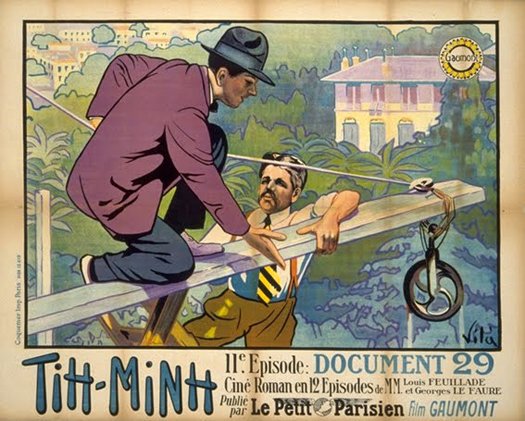
Jacques d’Athys returns to his home in the French Riviera after an expedition to Indochina, accompanied by Tih Minh, a young woman who saved his Life there. A letter mysteriously calls him away, then he returns with Tih Minh as his fiance, in addition to artifacts and a book that reveals the whereabouts of some treasure. However, the deadly trio of Dr. Gilson, Marquise Dolorès and the Hindu Kistna, who are already involved in thefts, hypnotism and a white slaver racket, know what’s in the book and want it desperately. Jacques has his plucky servant Placide around to help, but it might not be enough….
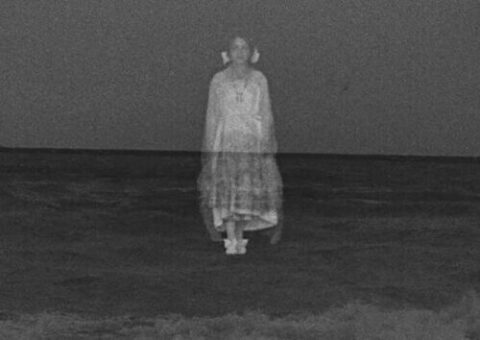
Tih Minh sees Feuillade trying some new things with his serials. Granted, Judex also differed a bit from Fantomas and Les Vampires, but not nearly as much; despite ostensibly putting more focus on a hero character, it still seemed more interested in the villains, and was set in the same world, a world where Paris and upper class types are threatened with destruction by vile villainy which seems to erupt from the lower classes. Yes, despite characters like the Artful Dodger, one can certainly see a rather reductant political element to these serials, even if it’s doubtful that audiences of the time minded. But Tih Minh, while it still has baddies out to cause chaos and commit crime, broadens the class element and takes place more against a colonialist backdrop. This is something that will date this one more than the others for some, seeing as we’re supposed to hate our colonialist past now, and with some justification though things can go too far in this direction, but this does help give it some freshness, and set against that is the fact that this is easily the most action-packed of the four, Feuillade perhaps taking some cues from the American cliffhanger serials that were becoming very popular in the States which focused on thrills above all else. The violence, despite there being few deaths, is increased too. However, it taking its title from its lead female character is deceptive, because, while she’s the focus of so much, she spends a lot of time being captured and in a daze, being more a metaphor for the “exoticism” of the East which European forces want to possess and control than a fully-fledged character. Meanwhile the supposed main hero is even more ineffectual than usual and, even more than him, has to have others do much of the work for him, particularly a would be-comical guy clearly filling in for Marcel Levesque, while the villains are highly incompetent. The filming is even more smoother and advanced, with some experimentation at work.
This one is introduced as “a cinematic novel” and with lengthy introductions to the main characters being basically themselves against a black background, though our title character is shown smelling then putting flowers in a jar, perhaps a deliberate indicator of her ineffectuality. The prologue could be omitted, being just a lengthier introduction to things, but it’s good anyway. We see explorer Jacques d’ Athys returning from Indochina to the welcoming arms of his mother and sister Jeanne, not to mention servant Rosette, to whom his “faithful servant” Placide is engaged; his kisses are so good that she faints. The only detail we learn of how Jacques and his companion Minh met is that she saved his life. Minh is soon supposedly happy with her “education”, “but a telegram would soon disrupt this harmony”, though we never learn how said telegram, which we see, fits in properly with the story. Now begins Episode 1, and Jacques and Placide have been in Indochina for two years. Meanwhile in Monte Carlo we meet our three villains – Dr. Gilson, Marquise Dolorès and the Hindu Kistna. A Lord Stone wins a lot of money at the gambling table, but is then found on a beach bench robbed and rather “out of it”. Apparently this isn’t a new occurrence and some people have been disappearing. The culprits are probably our deadly trio, who live at the Villa Circe, and who fill us in about this book which describes a legend, which contains the whereabouts of treasure, and which was stolen. All this is taken at a fast pace and it’s not long before Tih is kidnapped [for the first time], hypnotised by Kistma with the help of a potion, and told to steal the book, while Jacques worries about her absence, something lingered on without slowing things down, especially when she receives a card with a picture and the text “I’m still alive”, though both soon fade.
Jacques is invited to the Villa Circe for a party – rather amusingly he remembers the wicked Circe from “The Odyssey” which makes him realise it could be dangerous, though nothing bad happens to him there in a somewhat Bond-like sequence except for Dolores chatting him up. Dolores had just been helping Kistna cheat at cards by sending him telepathic visions of his opponent’s cards. Gilson asks him about the book, but, when Jacques sent Placide to fetch it earlier, the servant noticed the cipher written in pencil on the flyleaf and erased it. There was logical reason for him to do this – he doesn’t know of its importance – but never mind. However. Jacques photographed the pages, so the baddies are still in with a chance, especially seeing as Dolores’s charm that she wears around her neck can temporarily paralyse Jacques in one arm. Minh is released, but is in a daze and remembers nothing. Placide survives being pushed off a cliff, which is a shame, but never mind. Jacques then catches another hypnotised woman in his office looking for the book; she collapses. Jacques and Placide discover that our villainous trio have lots of women imprisoned in their villa using a supposed sanitarium as a cover; they feed them a drug to make them sleepy and do their bidding – a somewhat muddled plot device which nonetheless is the cause of a lot of fun, with various characters taking it or not taking it but having to act otherwise. The baddies are so psrsistent and Jacques is so useless that he has to call in three others – “orientalist” George Labour, Dr. Clouzil and diplomat Sir Francis Grey – to aid him, though Dolores might be having a change of heart.
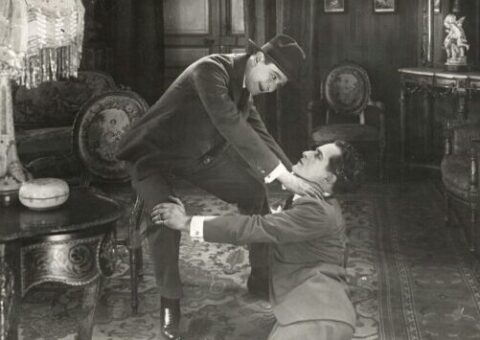
Initially the villains, while busy with their white slavery operation which leads to a rather dark scene where one imprisoned woman is attacked by all the others, are focused primarily on Tih and this written down “testament” that’s later called Article 29 which is something of great importance indeed, though the extremely large scale that we eventually realise the villains are working on is almost glossed over, even though the plot is the most cohesive out of these four serials. Feuillade employs his longest flashback yet but seems even more determined to confound viewers by having important events take place offscreen or return to them as flashbacks, most notably a suicide right near the end. However, this helps keep the pace going and the action just keeps on coming, especially in the second half, with plenty of fights and chases, including some thrills in a a quarry where the actors are quite clearly clambering around and falling for real at the actual location, while there’s some very suspenseful house exploring which even gets away with some laughs when Placide runs twice into a particular bad guy and they brawl. Meanwhile a bullet ricochets off a statue and hits a hand, and one head is bashed in with a shoe and two others with rocks. The comedy actually works a bit more here, such as a scene where Cosette doesn’t like Placide sleeping in the same room as Dolores so she sleeps in there too, even if more could have been done with it. And the filmmaking is very adept now, so much so that some fun devices like a dissolve showing what’s inside a briefcase can be employed; perhaps most memorable is when Tih is super-emposed over water as Jacques thinks of her, strengthening her portrayal as an object to be owned perhaps more than reinforcing his love for her. The device of the iris is employed creatively, yet charming things like a fake beard even more ridiculous unconvincing then the one in Les Vampires remain.
It’s nice seeing our initial supposed hero, who has a position of privilege, needing others, including folk from the “lower orders”, to do much of the work. Georges Biscot while he starts off as goofy and annoying as Placide, begins to downplay comical moments such as he not realising that a statue of a dog isn’t the real thing, and has to act increasingly serious as he becomes the real hero, engaging in punch-ups, hanging on to cars and climbing up telegraph poles, while Rene Creste’s Jacques spends more time looking concerned. Obviously Mary Harafd is saddled with playing more of a symbol more than a character, but she’s balanced out by Georgette Viroboni as Dolores, a villain who’s torn between both sides yet always retains a carnal earthiness. My initial feeling was that Isadora, for whom this role was probably intended, would be preferable, but as time went on I became more and more impressed with Viroboni, wbo’s able to pull off a more complex role in a less stylised manner. Unfortunately, Dolores’s own romance s given really short shrift; I’d have liked to have seen when these two people realise they’ve developed feelings for each other, but then we also have Placide and Cosette, and Jacques and Tih. But personally I feel that Ti Minh is the best of these four serials, even if it’s the least known and even if one ignores the obvious advancements in technique. Despite its dated attitudes which may niggle some but which I feel Fuellade was aware of – colonialism seems to be supported but just think of how Tih is portrayed – I can’t imagine many modern viewers getting bored with this exciting and inventive action serial.
Rating: 









DISC EIGHT
TIH MINH
1 – THE POTION OF FORGIVENESS [47 mins]
Brand new audio commentary by genre film expert and Video Watchdog founder Tim Lucas
Lucas is back and seems to see more in this than Judex, even though he doesn’t say as much. He points out parallels with Hitchcock movies – the final one a little strange but the first one presenting an interesting view of an element of the plot which I never noticed – tells us that rhe rwo villas in the serial do exist but in Italy rather than the French Riveiera, describes the original story referred to plus a terrific Hindu myth about a man-using goddess who was repetedlly reborrn as a dog which haa parallels with the way that Minh is handled which makes her inactive and objective status seem less frustrating. The most rewarding of his four tracks in this set.
2 – TWO DRAMATIC EVENTS DURING THE NIGHT [29 mins]
3 – THE MYSTERIES OF VILLA CIRCE [36 mins]
4 – THE MAN IN THE TRUNK [29 mins]
5 – AT THE ASYLUM [36 mins]
6 – THE NIGHT BIRDS [30 mins]
Brand new audio commentary by genre film expert and Video Watchdog founder Tim Lucas
It seems that not much is known about Harard, but Lucas finds plenty of other stuff to talk about, from feature films being supported by serial episodes to give the impression that the French film industry was prosperingh at the time even though US cinema had virtually taken over, to Feuillade’s awkwardness with the concept of the hero. He actually apologises for going off on a tangent [I wish more people doing commentaries would do this] before discussing a fascinating lost semi-horror movie called Li Hang The Cruel which had Harard in a supporting role; it was deemed racist and its rape scene too much, so it was eventually banned in France.
DISC NINE
TIH MINH continued
7 – EVOCATION [27 mins]
8 – BENEATH THE VEIL [28 mins]
9 – THE BRANCH OF SALVATION [39 mins]
10 – WEDNESDAY 13TH [35 mins]
11 – DOCUMENT 29 [31 mins]
12 – JUSTICE [22 mins
Brand new audio commentary by genre film expert and Video Watchdog founder Tim Lucas
Lucas begins by saying that for this and Judex he was contracted to only do two commentaries for each serial, or two full commentaries and one short commentary, but felt that he had more to say. This is an excellent final track, going through the previous episodes in a manner which highlights their diversity, stopping to discuss forebearers to James Bond because Ti Ming might be the first film to contain Bond-like elements, the origin of it all possibly being in a Fantomas novel where the title character behaves like a spy. He also points out a cameo by Feuillade himself, plus an instance where one actor took over the role of another. Tim really loves this one, calling it “one of the most beautiful and most savage films ever”.
A CLOSER LOOK AT FEUILLADE WITH TONY RAYNS [42 mins]
Rayns goes through Feuillade’s career and these four serials, and can’t help but regurgitate much of what’s been said before in commentaries and featurettes on this set, but does provide a few details, such as Feuillade having made short films in practically every genre, and his analysis of certain sections in each of the four serials presented here, all chosen for different but worthwhile reasons, is well worth listening to. He details a quickening of pace with each one, and then names some films influenced by Feuillade not named yet.
SET FEATURES
Limited Edition Hardcase Box Set [2000 copies]
Set includes all four serials across 9 Blu-ray Discs, all presented in 1080p HD from stunning 4K restorations courtesy of Gaumont Film Company
All four serials look amazingly good for the time; yes, they’ve faded, but the restorations are still darn good, meaning that the occasional iffy shots, probably sourced from other prints because they were missing from the main source or just damaged, stick out. Fantomas is tinted blue in nighttime scenes, the others are entirely black and white. The first two serials contain music by Robert Isreal from 2000; the veteran silent movie composer’s work is typically effective, finding a decent bridge between helping to provide the period feel and trying to be dramatic and appropriate accompaniment. Judex also had a score from Isreal in its previous release on disc but now it has an entirely piano score, which is more quaint but good enough. Tih Minh has the most interesting and diverse score of the four, with some percussive effects and even just slightly augmented natural being employed. I’m unable to identify the composers of the last two scores.
Uncompressed LPCM 2.0 audio on all serials
Fold-out poster
A limited edition 100-page collector’s book featuring new writing by Louis Feuillade experts Jonathan Rosenbaum, Calum Baker, Annette Förster, Wendy Haslem, Robin Walz and Leon Hunt on the filmmaker and his crime serials alongside select archival imagery
I recommend that you take your time watching them, but each one of these serials is better than the one before in this fascinating delve into pioneering cinema which is also just great fun. Highly Recommended!





Be the first to comment